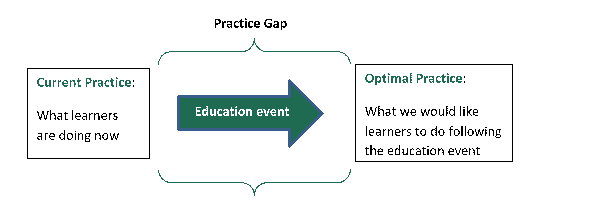Identifying and assessing needs for a specific activity
The ACCME Standard
According to the ACCME, Criterion 2 – The provider incorporates into CME activities the educational needs (knowledge, competence, or performance) that underlie the professional practice gaps of their own learners.
The basics are simple: let's design our education events based on objectives that identify a specific need among the learner community:

To satisfy the standard, we must document the methods and sources used to determine the specific educational needs to be addressed by any proposed activity, and this documentation must be based on evidence, i.e. it can include but can't rely entirely on faculty perception. Some independent evaluation must be conducted to verify the need, and document the presence of a gap.
- The essential process is one of collecting information to develop instruction that closes the gap between what a learner group knows (and does) vs. what the group should know (and do), i.e. the education is intended to bridge the gap between current actual and future desired practice
- So, ideally this happens prior to the development of any content
- The purpose is to identify and analyze a gap in knowledge, competence or performance, to serve as the basis for identifying relevant learning objectives that make the education event meaningful to the audience
- Sources of information can be categorized as (this is not an exhaustive list):
- Inferred needs: new methods of diagnosis or treatment that are not widely disseminated or used; new medications or indications; new technologies or regulatory requirements
- Perceived needs or interests: based on feedback, surveys, comments, or expert opinion
- Proven needs: quality data; epidemiological data; local/regional/national statistical data; professional society requirements; research literature